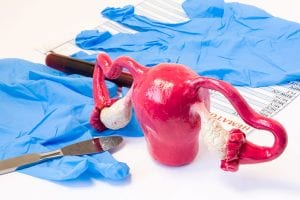
During a vaginal delivery, a doctor or midwife may perform an episiotomy. This is a surgical incision made from the posterior wall of the vagina back along the perineum. This is a common procedure, but it is performed currently on a case by case basis rather than on all women.
When is an Episiotomy Necessary?
 An episiotomy may be needed for a variety of reasons. These reasons include a fast third stage of labor where the perineum has not had time to slowly stretch. The baby’s head may be too large for the vaginal opening. If the baby is in distress and needs to be delivered quickly an incision may be necessary. If the mother needs the assistance of forceps or a vacuum to deliver the baby, an incision may be made to fit the instruments. If the baby is in a breech position with his buttocks presenting first, an incision may be needed in order for the baby to be delivered.
An episiotomy may be needed for a variety of reasons. These reasons include a fast third stage of labor where the perineum has not had time to slowly stretch. The baby’s head may be too large for the vaginal opening. If the baby is in distress and needs to be delivered quickly an incision may be necessary. If the mother needs the assistance of forceps or a vacuum to deliver the baby, an incision may be made to fit the instruments. If the baby is in a breech position with his buttocks presenting first, an incision may be needed in order for the baby to be delivered.
Forms of Episiotomy
There are different types of episiotomy.
In median episiotomy, the incision is made in the middle of the perineum in the direction of the anus. The connective tissue of the perineum is severed and the muscles remain intact. The advantage of this form is, that wound healing is best in this procedure and it rarely comes to complaints.
Mediolateral episiotomy is cut to the side from the middle of the perineum. This is the most common form of episiotomy, which involves less bowel injury and is typically used in vacuum-assisted delivery or forceps birth.
The lateral episiotomy is carried out from the side of the dam in the lateral direction. As wound healing complications are more common in this technique, it is only practiced in exceptional cases. If there is no epidural in place, a numbing agent will be injected into the perineum. After delivery, dissolvable stitches will be used to close the incision.
Although this surgical procedure today is typically performed due to medical necessity, there are some complications that can occur depending on the form of episiotomy. Some potential risks associated with this procedure include infection, bruising, swelling, bleeding, a prolonged healing time, scarring that may or may not be painful, and problems with incontinence.
What is the Recovery Process Like?
Pain following an incision can be relieved with a few methods. Cold packs on the area are usually available in the hospital or birthing center. They are typically inside the maxi packs used post-delivery. Sitz baths, in which only the buttocks and hips are immersed in water, can be helpful to soothe the area and keep it clean using warm water. Medications such as tucks pads and over the counter pain relievers can be helpful. Instead of using toilet paper to clean the area, a squirt bottle filled with warm water may be a better option immediately following delivery. For some women, there may be residual discomfort when sexual intercourse is resumed. A lubricant jelly can help alleviate some of that discomfort. In addition, a diet that only includes soft foods is recommended, as hard stools can lead to pain during defecation.
Prevention
Good pelvic floor training during pregnancy can ensure that the muscles in this area are more elastic. Also a perineal massage three to four weeks before birth can reduce the risk of perineal rapture. When it comes to herbal approaches, raspberry leaf tea is said to make the perineal, pelvic and uterine areas more elastic and relax the abdominal muscles.
There are also some things that can be done during labor to help prevent the need for an incision. The care provider may massage mineral oil into the perineum during the second stage of labor. This method may help prevent extensive tearing by softening the tissue. There is evidence that warm compresses on the perineum during labor can also help the tissue to stretch and alleviate tearing and incisions. In addition, birth position may also be decisive. Delivery in a squatting position or water birth can minimize the risk for an episiotomy.
It is important for women to let their providers know if they do not wish for a surgical incision to be performed. Although it cannot always be avoided, it is helpful to know the provider’s stance on the procedure and for them to understand the mother’s wishes.


